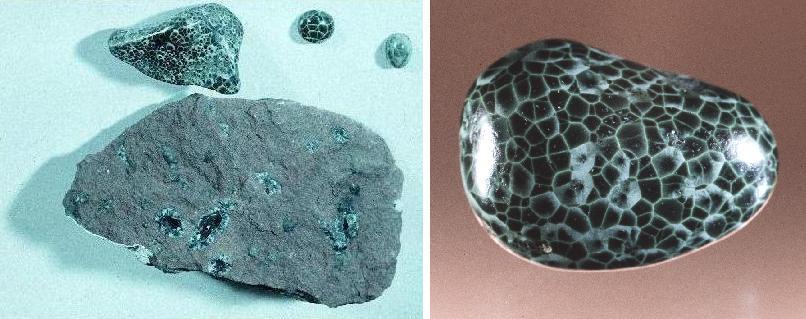( Fr- chlorastrolite; Ger- Chlorastrolith;
Nor- klorastrolitt; Rus- ![]() )
)
CHLORASTROLITE, (Compact, massive variety of pumpellyite -- Ca2(Mg,Fe)Al2(SiO4)
(Si2O7)(OH)2·H2O
).

A. Chlorastrolite pebbles (largest, greatest dimension ~1 cm) from Isle Royale, Michigan. The chiefly pink parts of three of the pebbles are identified as thomsonite. (© photo by Roger Weller, Cochise College)
B. Chlorastrolite (large irregularly
shaped
polished mass above hand specimen, width - 3.3 cm) from Isle Royale,
Michigan. Notice that the three amygdules that are between six
and eight o'clock in the hand specimen have hollow centers. R.V.
Dietrich collection. (© photo by D.L. Brittain)
C. Chlorastrolite,
polished specimen (width - ca.
2.5 cm)
from
Isle Royale, Michigan. Seaman Museum, Michigan Technological
University. (© photo by John Jaszczak)
DESCRIPTION: As noted above,
chlorastrolite
is a variety of the mineral pumpellyite.
Color - green and bluish green hues,
typically comprising finely radiated or stellate masses
H. 5½ - 6
S.G. 3.18-3.23
Light transmission - subtranslucent to opaque
Luster - pearly
Miscellany - individual stellate masses tend
to appear
chatoyant; some chlorastrolite includes native copper and/or
native silver and/or other one or more white, red, pink, green
and black
minerals, which are listed in the fourth paragraph under the REMARKS
subheading.
OTHER NAMES:
NOTEWORTHY LOCALITIES: Sporadically along the shore of Lake Superior -- e.g., along the shores of Keweenaw Peninsula and Isle Royale, Michigan; however, collecting chlorastrolite from Isle Royale, a National Park, is prohibited. In addition, several specimens have been collected from mines and mine tailings in Keweenaw County -- e.g., "the Central, Phoenix, Delaware and Central Exploration mines ... from which probably thousands of specimens have been recovered over the years" (George Robinson, personal communication, July 2005).
REMARKS: Chlorastrolite, the name,
is based on this gemrock's green color (Greek, chloritis) and the fact that its chatoyant
stellate groups resemble asterism (Greek, asterismos) -- i.e., it means "green star
stone." "One of the first documentations of Michigan's
semi-precious 'greenstone' came from Dr. C. Jackson and Dr. J. Whitney
in 1847. The two doctors named the small green stones from Isle
Royale 'chlorastrolite'." (www.geocities.com) The less said
about the frequently applied misnomer "greenstone," the better
(see, for example, Dietrich, 1983).
In the past, chlorastrolite was thought
to
be an impure variety of prehnite or thomsonite. A brief review of
the rather complex history of how chlorastrolite was once named
keasargeite and how it finally became recognized as a variety of
pumpellyite
is given on, for example, the web site www.deq.state.mi.us/documents/ deq-glm-rcim-geology-Greenstone.
Chlorastrolite, designated by the misnomer greenstone is the official state gemstone of Michigan. (see www.michigan.gov)
SIMULANT:
Zonochlorite - green banded pebbles found in the Lake Superior region that are wholly or chiefly prehnite that roughly resembles chlorastrolite (Merrill, 1922); see remarks given in Appendix A. - [may require non-macroscopic means].
REFERENCES: Dietrich, 1983.; Huber, 1975.
R. V. Dietrich © 2015
Last
update: 30 June 2005
web page created by Emmett Mason